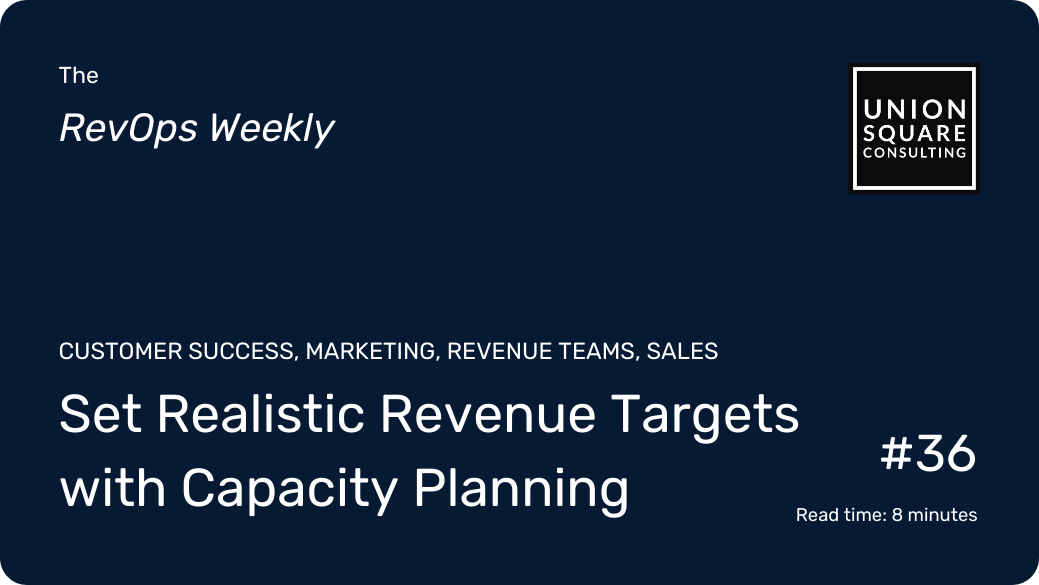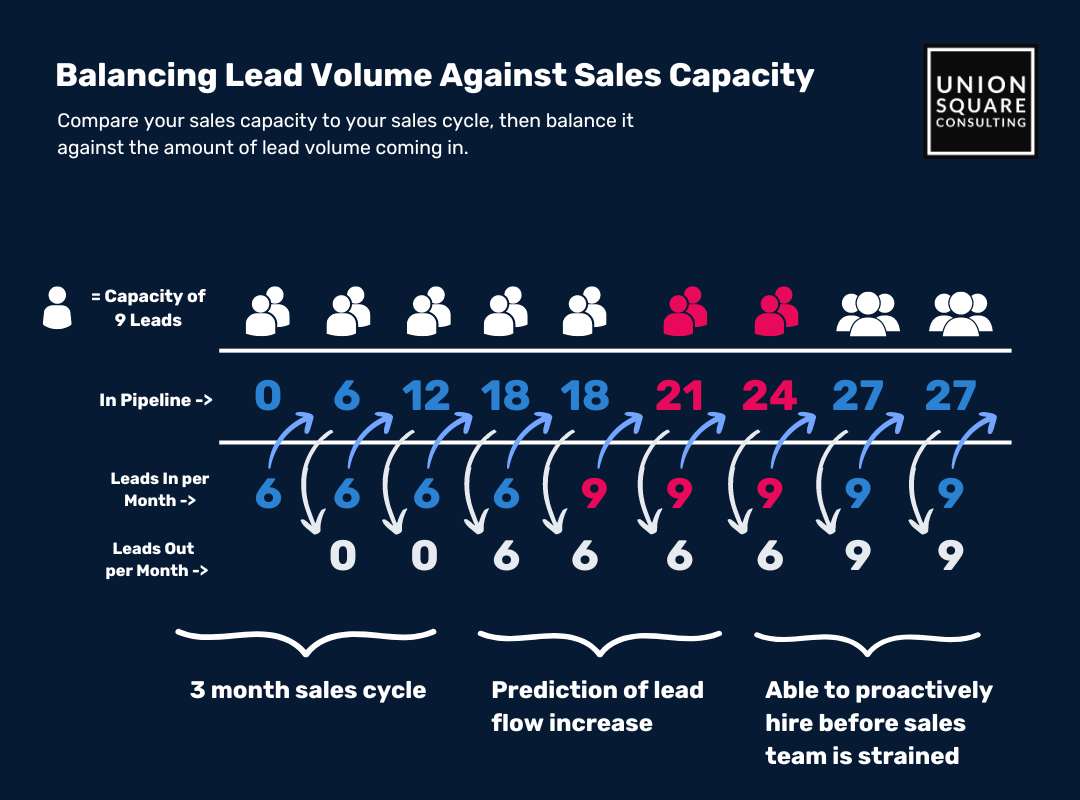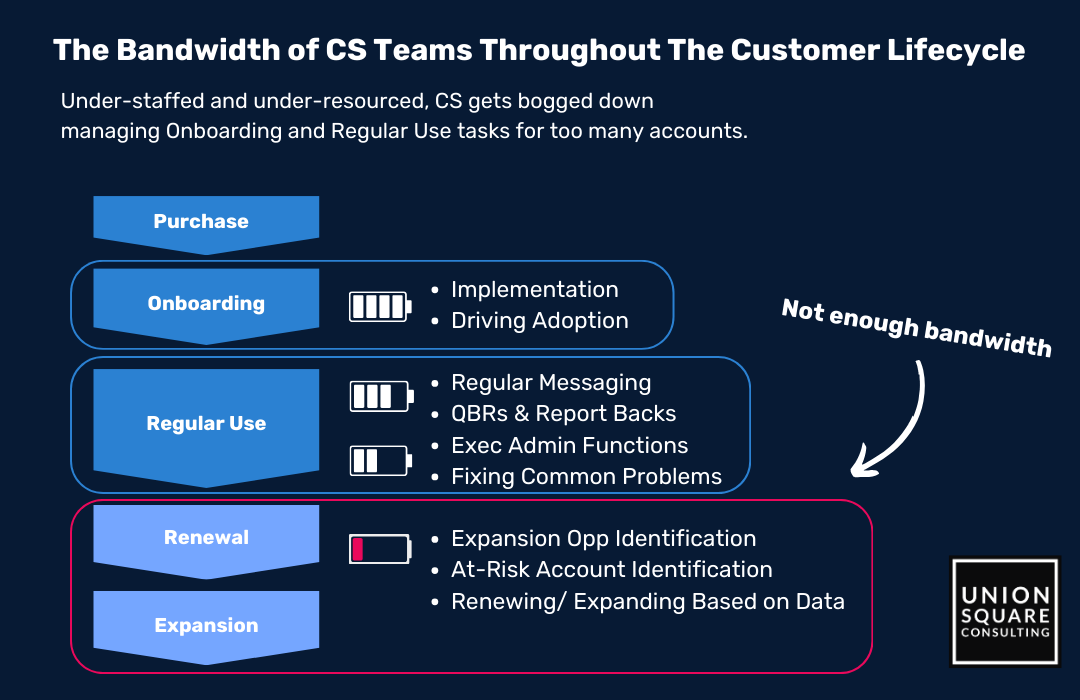
Set Realistic Revenue Targets with Capacity Planning
Read time: 9 minutesIt’s all too common for revenue teams to set goals for Sales, Marketing, and Customer Success without realizing they don’t have the capacity to reach those goals.
In many of the companies we see, capacity planning has never once been done and the organization’s GTM system has been designed based on a guess.
This leads to situations where a department is put on the hook for expectations that they don’t have people and/or resources to achieve.
How is Marketing supposed to increase leads with the same budget and people?
How is Sales meant to increase revenue production with the same people making the same calls and working the same number of deals?
How is CS expected to take on even more customers with the same under-resourced team and give every account a great experience?
The answer to all of this is, they don’t. And your GTM motion begins to stall as a result.
Talk about an efficiency killer. So how do we start capacity planning?
First, when we think about capacity planning we need to be specific to the team we’re working with. Marketing, Sales, and Customer Success will all have different capacity models to follow.
Plus, within those departments, every team will have their own idiosyncrasies. For this newsletter, we’ll be staying high-level to recommend philosophies and tactics that apply in all cases.
Capacity Planning for Marketing: Show Me the Money
Marketing has the easiest and the most abstract capacity model of them all. By far, it’s the most scalable of the three main GTM functions.
This means that the capacity is not driven by individual members of the team, but by the amount of financial resources at your disposal.
(The exception being, if your business is driven by trade shows, you have a limit to the number of shows you can support with the employees you have.)
To see your marketing capacity, you’ll have to link each of your marketing channels to the expected booking value of the leads you’ve generated through them. This allows you to take your attribution model (whatever yours happens to be) and apply an objective output to it.
If we know that we’ve generated $X output and we’ve spent $Y to achieve that, then we can get a rough ROI metric. Your capacity limitations in terms of budget can then be balanced with the highest-performing channels.
Do this right, and you should be able to set realistic marketing goals based on budget and capital allocation.
Capacity Planning For Sales: Most Companies Get This Wrong
You can’t just look back at what reps sold last year, use that as this year’s capacity, and call it a day. There’s absolutely no consistent application of historical bookings in determining your present sales capacity.
90% of organizations try to capacity plan Sales this way. They get it wrong because they’re judging capacity based on an unrelated performance metric.
It’s like trying to figure out what the top speed of a car is by sitting in a parking lot with a speed detector. Wrong place to look.
In Sales, capacity is the number of opportunities each rep can effectively manage at once without getting overwhelmed and seeing a decrease in their win rate or losing sufficient time to prospect.
This visibility allows you to make proactive decisions with pipeline management, territory planning, and hiring.
The concept is easy. Getting that number is hard.
The best rule of thumb is to ask Sales Managers what their expectations are of the team. This sounds too simple, but we must understand the following constraints:
- Timed studies are difficult to run
- Every individual’s capacity is going to be different and fluctuate
- Therefore you likely won’t be able to test capacity via an experiment
- The only constant is that reps need to make sure they meet manager expectations
Your Sales Manager should know their team well enough to have an idea of what their limit is before their performance begins dropping. This number should be close enough to the pin to be usable for planning and load balancing.
Once you have this number, you need to compare it to your sales cycle and win rate, then balance it against the amount of lead volume coming in.
For example; let’s say you have 2 reps, each with a capacity of 9 opportunities at any given time, with a 3 month sales cycle. If your lead volume is 6 new leads entering the pipeline per month, your reps are currently at capacity.
Now, when Marketing forecasts an increase of lead volume to 9 new leads per month, you know that you need to hire 1 more rep and have them trained up by the time that new lead volume starts hitting.
Understanding your teams’ capacity allows you to be proactive instead of waiting for everything to be on fire before you step in.
If you are under-capacity:
- Reps do not have enough leads to realistically hit quota
- Reps spend most their time prospecting but it’s not enough
If you are over-capacity:
- Reps are being stretched too thin across too many accounts
- Win rate suffers because they are not able to work effectively
Both situations are going to cause revenue leakage and it’s hard to say which one is worse. Which is why you use capacity planning to decide if you need to hire more reps or focus on increasing lead volume with Marketing.
A rep’s capacity will also limit their ability to hit quota. If the quota you assign is above and beyond their capacity, they’re simply not going to reach it no matter how hard you push them. There just isn’t enough time in the day.
Capacity Planning For CS: Your Ticket to Higher Retention
Customer Success is likely the department in your organization that needs capacity planning the most.
It’s notoriously under-resourced and under-staffed. CS people are stretched across so many accounts that there’s no possible way for them to do what they need to do for every single customer.
This leads to:
- Many customers receiving a poor experience
- Renewals being lost or missed entirely
- No bandwidth for expansion initiatives
Capacity in this regard isn’t the number of accounts reps are currently carrying. It’s not about ARR under management (which has nothing to do with how difficult a customer is).
It’s about the activities a CS person must carry out with each and every account in order to maximize their success with your product.
This list should include tasks such as:
- QBRs
- Report backs
- Account planning
- Check-in meetings
- Identifying at-risk customers
- Identifying customers with upsell potential
- Etc.
I expect most people will be amazed at the number of these items. Add in an expected prep/execute/follow-up for each item and suddenly there’s a lot to do.
Map the time required to do this (again, with every account) to the number of working hours in a year for a CS person.
Et voila,– you have a capacity in terms of the number of accounts a CS person can effectively manage.
The last step is to compare this capacity to the number of accounts your CS people are currently working. You’re likely going to discover that you’re due for some hiring.
I’ve found that this exercise is always an “Aha!” moment for leadership.
They suddenly realize how understaffed the most important role in the revenue team is.
Unfortunately, as other executives and the board get involved, CS is the first place where cuts are made. Stick to your guns here and you’ll be rewarded with a high-performing, high-retention business… the bedrock of any SaaS company’s success.
Need Help Doing This for Your Organization?
Capacity planning is just one small part of everything we do at Union Square Consulting.
If you need help with this process, unsure if your business needs it, or are wondering what else we can do to improve your organization’s revenue efficiency, you have options!
- Book a free, 1:1 Revenue Efficiency Workshop with a Senior Revenue Strategist
- Learn more about our 1:1 Weekly Strategic RevOps Coaching program
- Check out the three RevOps packages we offer
TL;DR
- Capacity planning is essential to the design of your organization
- Without capacity planning, you risk:
- Wasting resources due to being under-capacity
- Stalling your GTM motion due to being over-capacity
- Every department capacity plans differently
- Capacity planning for Marketing:
- Link marketing channels to expected booking value of leads generated
- Balance your highest-performing channels with your budget
- This allows you to set realistic marketing quotas
- Capacity planning for Sales:
- Ask sales managers how many oppty’s their team can handle at one time
- Before their performance drops and win rate decreases
- Compare this number to sales cycle and win rate
- Balance against incoming lead volume
- Capacity planning in CS:
- List out all of the tasks a CS person must do for every single account
- Map the time cost of this to the number of working hours in a year
- This gives you the number of accounts a CS person can manage
- (Without performance dropping and retention suffering)
When you’re ready, here’s how we can help:
Get a Free 1:1 Revenue Efficiency Workshop
Get one of our Senior Revenue Strategists to yourself for 1 hour and leave with a plan to increase the money-making power of your go-to-market operations.
Hire Us!
Bring us on as your Strategic RevOps Team and realize the growth potential of your revenue engine. There are 3 ways to work with us.
Get more tips like these, sent right to your inbox.
Subscribe for fresh, relevant revenue growth tips delivered every week.

